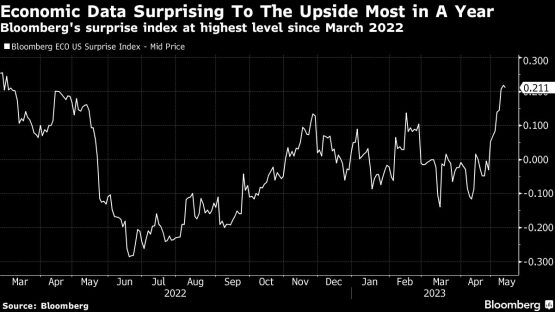Federal Reserve officials are likely to deliver their biggest upward revision to the US economic outlook since 2021 next month, as stress in the banking sector and a looming debt default belie the underlying strength of the economy.
That’s likely to reinforce their plan to keep rates at the peak level through the end of the year and into early 2024, despite a growing expectation among economists — including inside the central bank — that a recession will arrive over the coming months.
“They are going to have to raise GDP and lower unemployment for the year,” said Julia Coronado, president of MacroPolicy Perspectives LLC and a former Fed economist. “It definitely reinforces higher for longer. The Fed isn’t going to be turning around and cutting anytime soon.”
Policymakers have plenty of reasons to be more optimistic about the three-year-old expansion: Robust job growth has continued to exceed forecasts, auto sales are at a nearly two-year high, new home sales were the highest in a year in March, and manufacturing is showing signs of stabilising.
That will likely prompt the Federal Open Market Committee to boost its 2023 economic growth forecast to around 1% from 0.4%, and cut its unemployment rate expected late this year to around 4% from its prior estimate of 4.5%, said Stephen Stanley, chief US economist at Santander US Capital Markets in New York.
Those figures still would reflect a much slower second half of the year though not a recession, which has been Chair Jerome Powell’s view of the outlook.
Stanley said the FOMC’s March unemployment estimate – 1.1 percentage point higher than unemployment in April – seems impossible absent a “really severe” recession. “They’ve been way too pessimistic about 2023 and their projections all across the board,” he said.
While most Wall Street economists – and the Fed staff – are predicting a recession in the next year, there’s been mainly indications of moderating growth rather than any sharp drop in demand.
Growth averaged 1.1% in the first quarter and is tracking 2.9% so far for the second quarter, according to the Atlanta Fed’s gross domestic product tracker, and 2% per Goldman Sachs economists’ tracking.

Bloomberg’s US surprise index, which reflects whether economic data tops or misses consensus Wall Street estimates, rose this month to the highest level since March 2022.
“FOMC participants, like most forecasters, have to be surprised by the resilience of the economy,” said Vincent Reinhart, chief economist at Dreyfus and Mellon who previously spent more than two decades working at the Fed. “It’s got more momentum,” and any recession forecasts will need to be pushed out. “They will mark up their forecast.”
The FOMC revisions face some crosscurrents, as the US banking sector has been roiled by the failure of regional lenders, fanning concern that the strains could tip the economy into a downturn. The Fed’s quarterly survey of lending officers showed that banks reported tighter standards and weaker demand for loans in the first quarter, extending a trend that began last year.
Consumer confidence has been weak as well, with the University of Michigan’s consumer sentiment index the lowest since November — though weak sentiment in 2021 and 2022 didn’t correlate with downturns in the economy.
What Bloomberg Economics Says…
“I think it’s too early yet to say they will have to change their forecast significantly. … [The] FOMC’s 4.5% unemployment rate is actually not outrageous even given the strength of monthly nonfarm payrolls we are seeing right now — in fact entirely in line with what unemployment would look like historically if a recession were to begin this summer.”
— Stuart Paul and Anna Wong, economists
Powell at the May 3 press conference suggested that policymakers’ March forecasts would need to be updated, pointing out that participants didn’t have access to the first-quarter GDP report, which showed 1.1% growth and a 3.7% increase in consumption.
US central bankers have raised the benchmark lending rate 10 consecutive times to a range of 5% to 5.25% as they try to constrain too-high inflation. While Powell seemed to suggest a pause in rate hikes is likely in June, he also said policy decisions would be made meeting-by-meeting based on a variety of incoming data.
The Fed has been especially focused on an overheated labor market. Consumers have been buoyed by rising real wages as inflation has started to fall, with median wages rising 6.1% according to the Atlanta Fed’s Wage Growth Tracker, compared with a 4.9% rise in consumer prices.
The strength could lead to a “hawkish pause” in June, in which the Fed won’t raise rates but will signal the possibility of future hikes, said Matt Colyar, Moody’s Analytics economist.
“Strong income growth is now outpacing in a lot of ways inflation,” and that “bodes well for consumer spending,” said Colyar. “There’s a strength there that will keep the expansion moving along and prevent any kind of prolonged or severe downturn.”

The Fed isn’t the only central bank revising its outlook. The Bank of England on May 11 delivered its biggest upward revision in growth projections since the BOE gained independence in 1997, erasing a recession previously forecast. The UK central bank lifted its key rate a quarter point as expected to 4.5%.
St. Louis Fed President James Bullard, a leading hawk, said he has an upbeat view of the economic outlook and expects ‘’a stronger labour market than others have.” While he’s willing to await additional data before pushing for more near-term rate hikes, he said May 5 if his forecast is realised, “I think we are going to have to grind higher in terms of the policy rate.”
© 2023 Bloomberg

